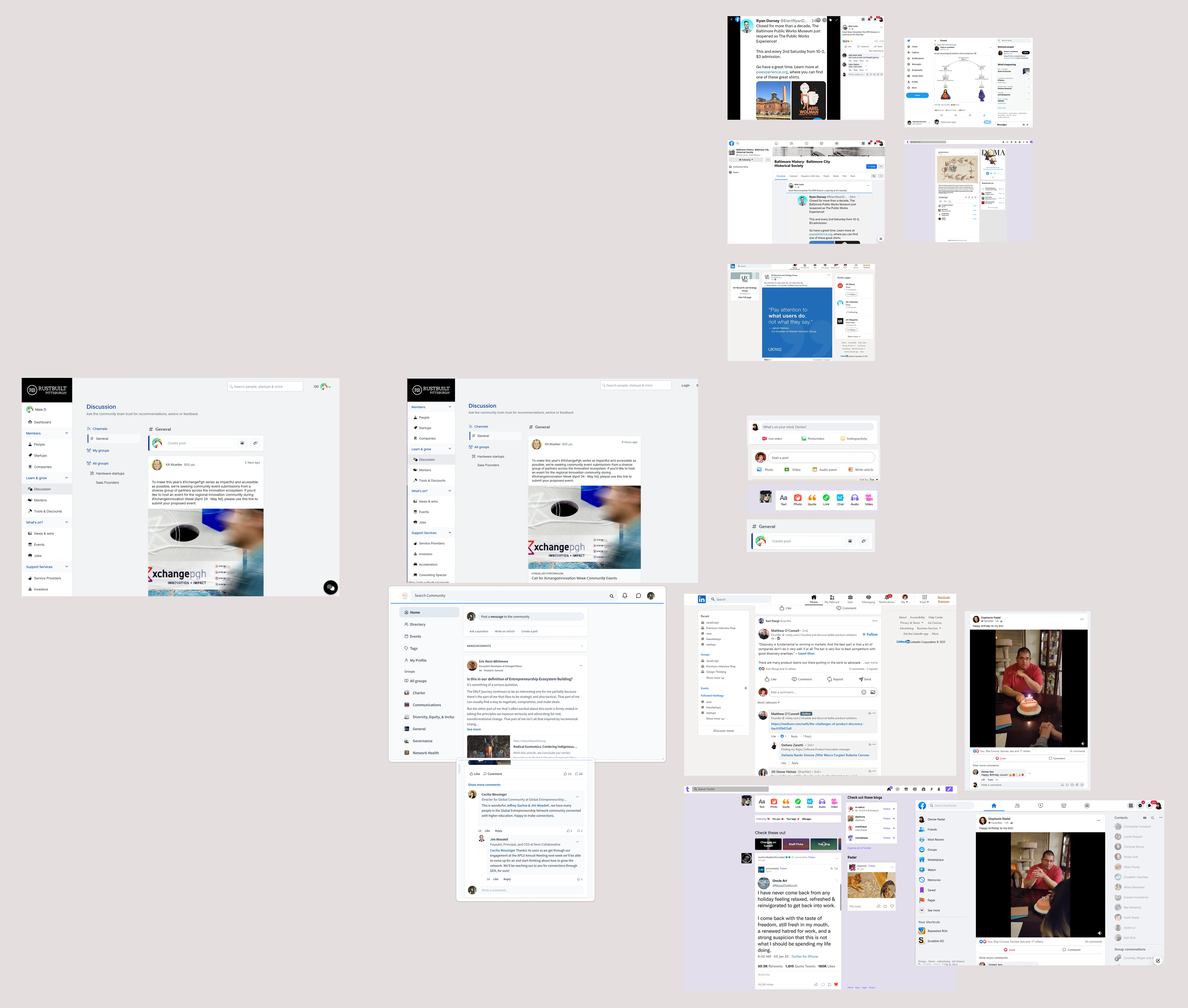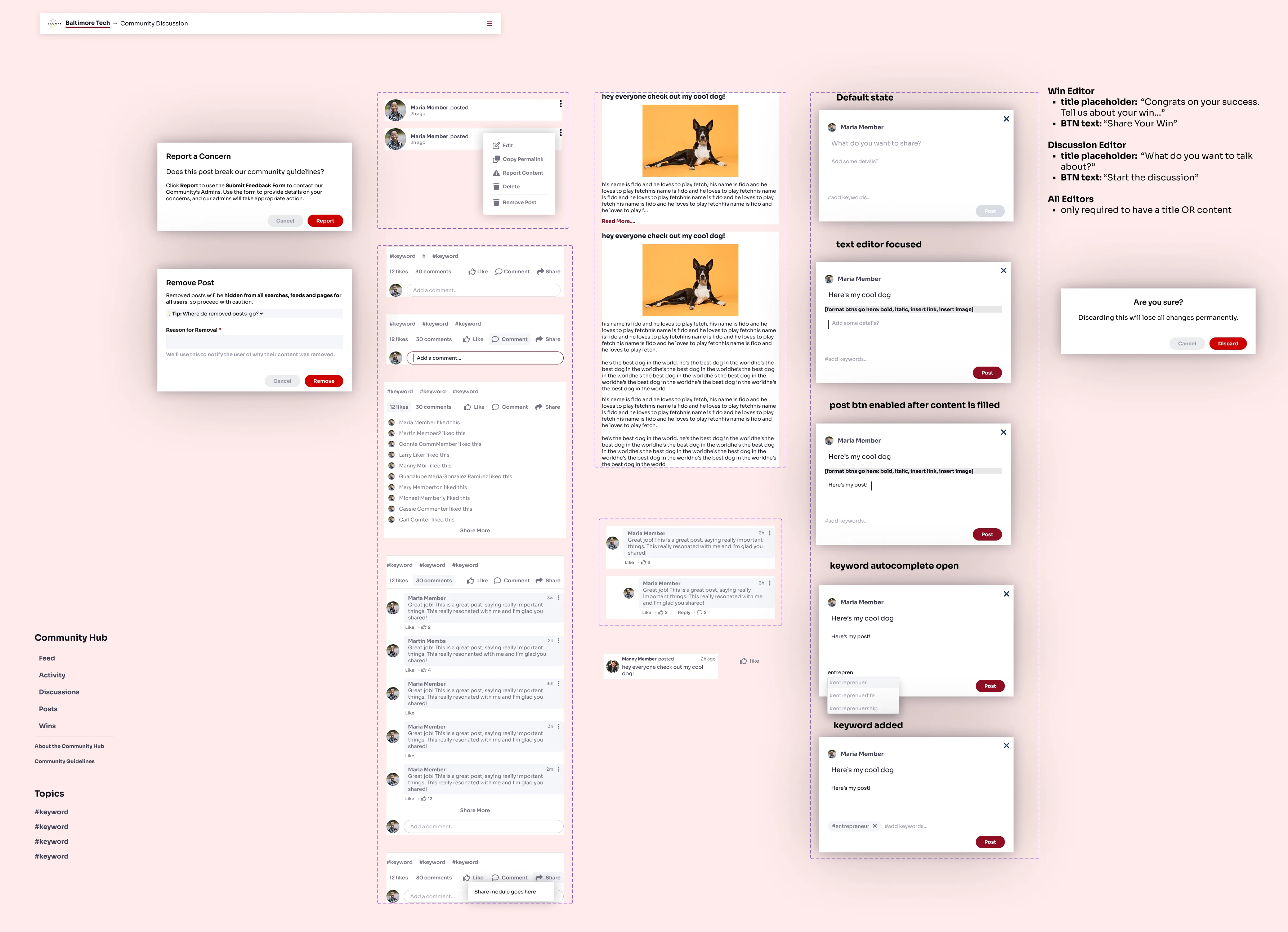
Platform Community Hub
Learning from a Strategic Misfire
How a well-intentioned feature taught us critical lessons about user behavior and platform design
- Role
- UI/UX Designer & Design Engineer
- Timeline:
- 4 weeks ◊ Spring 2023
- Team ◊ EcoMap Technologies
- Denise Nadal, Shua
- Impact
-
- Increased close rate for sales
- decreased customer satisfaction 🙃
Strategic Vision
Our CEO and founder Pava identified what seemed like a clear market opportunity: customers and prospects consistently expressed interest in community networking capabilities. The hypothesis was compelling - add a Community Hub for discussions and networking to increase customer acquisition, boost user engagement, and match competitive offerings in our space.
Fast-Track Development
With competitive pressure and customer demand driving urgency, we opted for a rapid development approach that prioritized speed over extensive research.
Research Approach
- Competitive analysis of existing community platforms and discussion forums
- Pattern identification across social media applications
- UI/UX benchmarking for common interaction flows
Design & Development Strategy
- Concurrent design and architecture - UI design and data structure planning happened simultaneously
- Compressed timeline - Full feature design completed within days
- Collaborative QA with primary developer before customer release
Reality Check
We successfully delivered the promised feature to customers, but the results revealed fundamental assumptions we hadn't tested.
What We Discovered
1. Usage Pattern Mismatch
Our platforms served a "find and go" user journey - people came with specific needs, found resources, and left. This didn't align with the sustained engagement required for community building.
2. Maintenance Burden
Communities require active moderation, outreach, and ongoing engagement. Our customers were already stretched thin with their core responsibilities and couldn't take on community management duties.
3. Audience Reality
The platforms lacked the regular, returning audience necessary for organic community growth. Without consistent users, discussions never gained momentum.
Quantitative Results
- Low engagement rates across all customer implementations
- Minimal user-generated content despite available functionality
- Zero organic community growth without active intervention
Strategic Learnings
This project became one of our most valuable learning experiences, providing crucial insights for future feature development.
Key Insights
User behavior trumps feature wishes. What customers say they want and how they actually behave can be fundamentally different. Our platforms weren't designed for community engagement patterns.
Context matters more than capability. Building community features without the right user context and engagement patterns meant we were solving for symptoms, not root causes.
Operational requirements need upfront consideration. Features that require ongoing maintenance from customers need to account for their capacity constraints.
What We'd Do Differently
Enhanced Research Phase:
- Deep-dive user journey analysis before feature development
- Customer workflow capacity assessment
- Pilot testing with select engaged user groups
Alternative Solutions:
- AI-powered engagement - Chatbot to initiate discussions and respond to posts
- Automated community seeding - System-generated conversation starters
- Lightweight interaction models - Lower-commitment engagement options
Value of Strategic Failure
While the Community Hub didn't achieve its intended goals, it provided invaluable strategic intelligence:
Product Strategy Evolution
- User-behavior-first design approach for future features
- Operational impact assessment as standard practice
- Pilot program methodology for testing engagement assumptions
Customer Relationship Insights
- Deeper understanding of customer capacity constraints
- Recognition of the gap between stated needs and actual usage patterns
- Framework for evaluating community-building prerequisites
Reflection
Not every feature succeeds, but every feature teaches. Community Hub demonstrated the importance of aligning feature design with actual user behavior rather than expressed preferences. While we didn't achieve the engagement goals, we gained strategic clarity that prevented similar missteps and informed more successful community-building approaches.
The experience reinforced that sometimes the most valuable insights come from understanding why something doesn't work, rather than just celebrating what does.
This project exemplified how thoughtful analysis of "failed" features can provide strategic direction and prevent larger design mistakes down the road.





